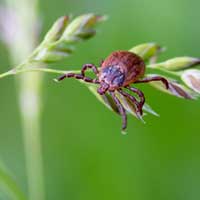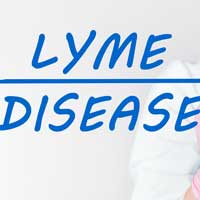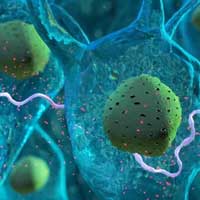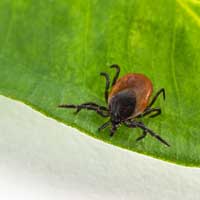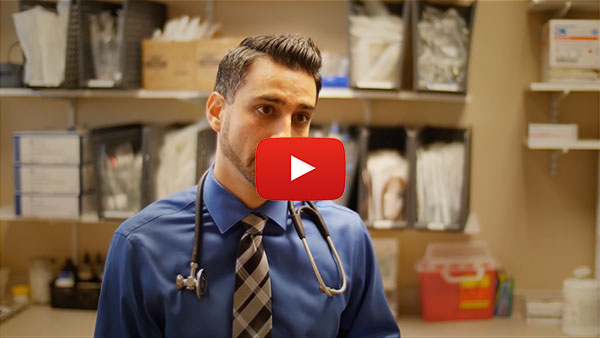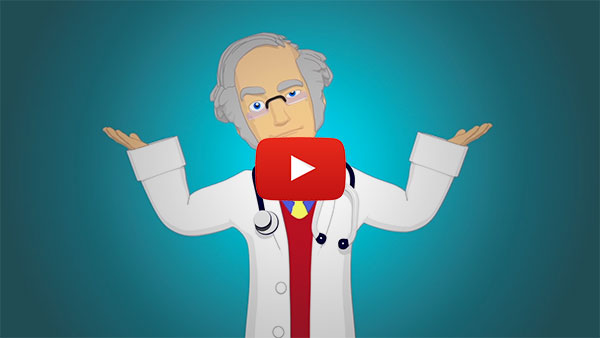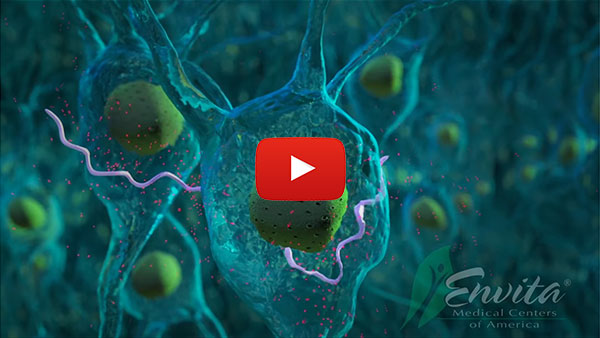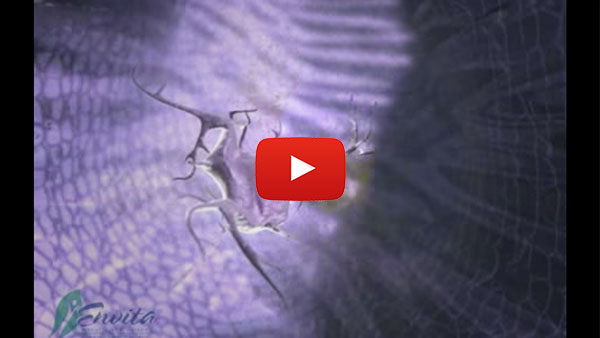Bartonella, A Chronic Lyme Disease Coinfection, is More Causing Chronic Fatigue Problems

Bartonella are bacteria that live within cells and find human beings quite hospitable. Bartonella henselae is the causative agent of the notorious cat-scratch fever, endocarditis, and several other serious diseases in humans. These bacteria comprise one of Lyme disease complex's most troublesome coinfections.
The bacteria are transferred by fleas, body lice, and ticks – with ticks being the greatest source of human bartonellosis infection, often accompanied by Lyme disease. Sand flies carry the bacteria in Peru's Andes Mountains in Colombia and Ecuador, while human body lice carriers are found throughout the world. The European sheep tick is a known carrier and five different species of Bartonella have been detected in nearly 20 percent of I. Pacificus ticks collected in California.
A Wide Range of Bartonellosis Symptoms
Bartonellosis can present as a mild infection or produce serious symptoms that affect the whole body. Early symptoms of the Lyme disease coinfection include fever, fatigue, headache, poor appetite, and even an unusual, streaked rash. Swollen glands around the head, neck, and arms are typical. Bartonellosis is generally suspected when neurological symptoms are out of proportion to other systemic, chronic Lyme disease symptoms. Patients may suffer with gastritis, lower abdominal pain, sore soles, and tender subcutaneous nodules along the extremities. Lymph nodes may be enlarged and accompanied by a sore throat. Additional manifestations may include:
- Bacillary angiomatosis and peliosis hepatitis
- Carrión's disease (includes both Oroya fever and verruga peruana)
- Cat scratch fever
- Endocarditis (inflammation of the heart valves)
- Erythema nodosum (inflammation of fat cells under the skin)
- Recurrent bacteremia (bacteria in the blood)
- Uveitis (eye inflammation)
- Thrombocytopenic purpura (low blood platelets)
Neurological Symptoms with Lyme disease Coinfections and Susceptibility to Seizures
It is not uncommon for patients with the Lyme disease coinfection Bartonella to contract encephalopathy, a brain disorder or disease. Up to 50 percent of patients who develop encephalopathy can be affected by seizures ranging from focal to generalized, and from brief and self-limited to status epilepticus, a dangerous condition in which epileptic seizures follow one another without recovery of consciousness between them. Headaches, cognitive dysfunction, and CNS lesions can all be related to Bartonella.
The Life Cycle and Spread of Bartonella
Bartonella dwell within various host animals without causing significant disease. Each host animal has one or more species of Bartonella that is particularly fond of it. Cats often carry B. henselae and B. clarridgeiae strains, while wild rats harbor B. doshiae, B. grahamii, B. taylorii, and B. tribocorum.
The Immune System is Critical for Long-Term Bartonella Treatment
In one case, a child was found to be infected by HHV-6 and just two months later began an acute lymphoblastic leukemia infection. This is just another example of the suggestion that viral infections could play a major causative role in some childhood leukemia.
HHV-6 Attacks P53, Giving Rise to Cancers
The effects of these bacteria depend on the status of the patient's immune system. An infected person with a healthy immune system may have minor symptoms that disappear in a short time, while the immunocompromised may have high numbers of bacteria that persist in the blood and tissues and cause ongoing symptoms. This is often the case with people who have Lyme disease and other Lyme coinfections. Chronic Lyme disease patients or patients with other forms of co-infections will virtually all express an immunocompromised condition.
Establishing a strong immune system is critical to treating Lyme disease complex. At Envita, we don't just test for infections, rather, we prefer to identify each patient's immune status. Then, we proceed with the most effective treatments from around the world to optimize and enhance their immune systems' health and functionality – best serving their Lyme disease treatment.
Diagnosis Errors - False Negatives in Immuno-Compromised Patients
Bartonella organisms can occasionally be visualized by immunohistochemical staining. By and large, this method of diagnosis is typically reserved for those with angiomatosis. The genetic code of various Bartonella species may also be amplified by PCR in blood, spinal fluid, and tissue. Considering the cross-reactivity of antibody tests, PCR may very well be the most reliable method to identify such infection. And, while it is possible to do a culture of the organisms, they are generally slow-growing in the lab, limiting its usefulness as a method of diagnosis. It should be noted that false negative serological results may occur among the immunocompromised. Sufferers of Lyme disease Complex of coinfections should be considered among the immunodeficient.
Treatment Difficulties and Complications
The difficulty in finding a suitable treatment protocol for Lyme disease co-infection Bartonella, comes from the fact that antibiotics slow down its reproduction process, but are unlikely to kill the infection. Moreover, Bartonella is often sequestered inside the erythrocytes or red blood cells. This, combined with an already weakened immune system, further complicates treatment. On top of this, patients often simultaneously face borreliosis, candida, HHV-6 and/or have other toxins, such as heavy metals which complicate how we can approach this Lyme disease treatment.
Bartonella Characteristics Allowing for Immune Evasion
Clincal and in vitro studies related to the Lyme disease coinfection Bartonella implicated a Th1 immune response. The old Bartonella skin test required an intradermal injection of suppurative material derived from the lymph nodes of cat scratch disease patients. Results were considered positive if a large erythematous area developed on the skin within two days.
This delayed-type hypersensitivity reaction is mediated through the Th1 immune response. A Th1 response was also supported through in vitro studies among mice with splenocytes who showed an increase in the production of Th1 cytokines in response to B. henselea. Elevated IL-8 demonstrates the role of innate immunity in response to the same B. henselea.
The role of cytokines in acute and chronic Bartonella infection was considered in various other studies. Immune competent subjects with CSD suffering acute infections revealed upregulation of pro-inflammatory and anti-inflammatory cytokines. On the other hand, low CD4 counts have been associated with elevated IL-10 levels during times of acute Bartonella infection.
When it comes to studies involving the immunocompromised (this includes all Lyme disease patients) it typically revolves around the establishment of bacterial stimulated angiogenesis. Unfortunately, understanding the details regarding Bartonella species has been greatly hampered by not having a good animal model.
As it is clear that response as it pertains to a competent immune system involves Th1 and innate immunity (macrophages) we may conclude that HIV-positive patients (as well as others who are immunodeficient in these areas) would find it extremely challenging to limit this infection. That being said, we cannot say definitively that this is the method by which HIV aids the spread of Bartonella.
What we do know is that intraerythrocytic persistence is characteristic of infections within immune-competent hosts. Endothelial and periendothelial persistence leading to vasoproliferation is a characteristic exhibited among the immunocompromised.
The makeup Bartonella Lipopolysaccharide (LPS) includes Lipid A as well as long-chain fatty acids that allow the bacteria to evade the immune system. Data has shown the surface molecules of Lyme disease co-infection Bartonella, will go unrecognized by TLR-4 on dendritic cells and macrophages – a recipe for persistent infection.
B. henselae avoids lysosomal fusion and acidification even after the bacteria invades endothelial cells and macrophages. That being said, exactly how local bacterial control is lost in immunocompromised subjects is unclear.
Bacterial Persistence: Pro- and Anti-Inflammatory Response
Clincal and in vitro studies related to the Lyme disease coinfection Bartonella implicated a Th1 immune response. The old Bartonella skin test required an intradermal injection of suppurative material derived from the lymph nodes of cat scratch disease patients. Results were considered positive if a large erythematous area developed on the skin within two days.
This delayed-type hypersensitivity reaction is mediated through the Th1 immune response. A Th1 response was also supported through in vitro studies among mice with splenocytes who showed an increase in the production of Th1 cytokines in response to B. henselea. Elevated IL-8 demonstrates the role of innate immunity in response to the same B. henselea.
The role of cytokines in acute and chronic Bartonella infection was considered in various other studies. Immune competent subjects with CSD suffering acute infections revealed upregulation of pro-inflammatory and anti-inflammatory cytokines. On the other hand, low CD4 counts have been associated with elevated IL-10 levels during times of acute Bartonella infection.
When it comes to studies involving the immunocompromised (this includes all Lyme disease patients) it typically revolves around the establishment of bacterial stimulated angiogenesis. Unfortunately, understanding the details regarding Bartonella species has been greatly hampered by not having a good animal model. As it is clear that response as it pertains to a competent immune system involves Th1 and innate immunity (macrophages) we may conclude that HIV-positive patients (as well as others who are immunodeficient in these areas) would find it extremely challenging to limit this infection. That being said, we cannot say definitively that this is the method by which HIV aids the spread of Bartonella.
What we do know is that intraerythrocytic persistence is characteristic of infections within immune-competent hosts. Endothelial and periendothelial persistence leading to vasoproliferation is a characteristic exhibited among the immunocompromised.
Angiogenesis in Bartonella Complications
Bacillary angiomatosis is the most common disease resultant of B. buintana and B. henselae infections in those with cell-mediated immunodeficiency resultant of HIV or posttransplant patients who have been prescribed a regimen of immunosuppressive therapy. Manifestations include its characteristic vasoproliferative lesion, bacillary angiomatosis, and others due to both direct and indirect effect on endothelial cells.
Additional issues with these strains are often sustained as these particular Lyme disease co-infections persist in localized bacterial replication within the host's collagen tissue, resulting in an antiapoptotic state in the endolthelial cells via effector protein excretion – resulting in proliferation.
Furthermore Bartonella infection may play a role in the development of bacillary angiomatosis as elevated levels have been detected in both animal and human studies. However, this is not the case among immune-competent subjects with CSD who experience an increase in leukocyte rolling and adhesion causing a proinflammatory environment.
To learn more about these infection and related symptoms of fatigue, chronic fatigue syndrome and fibromyalgia like symptoms, contact us today. We would happily answer any questions you may have.











